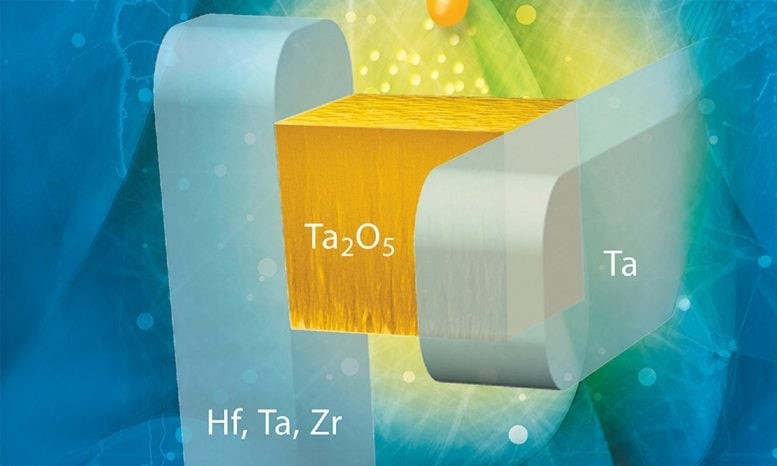Brain-Inspired Memristor May Finally Overcome AI’s "Catastrophic Forgetting"
Exploring AI’s Challenge of “Catastrophic Forgetting
Deep neural networks struggle with a phenomenon called “catastrophic forgetting,” where learning a new task can overwrite previously acquired knowledge. In contrast, the human brain mitigates this issue by regulating how strongly synapses adapt during learning. This capability, known as “metaplasticity,” allows the brain to adjust its own plasticity, enabling new learning without erasing past memories.

Figure 1. Brain-Inspired Memristor: A Breakthrough Against AI’s “Catastrophic Forgetting.
The Unique Properties of Memristors
With advancements in computer hardware, memristors—short for memory resistors—are gaining attention as key components in neuromorphic computing. Unlike traditional resistors, memristors can adjust their resistance based on applied voltage and retain this state even after power is removed. This memory effect arises from physical changes within the device, such as atomic migration and structural modifications in the electrodes. Figure 1 shows Brain-Inspired Memristor: A Breakthrough Against AI’s “Catastrophic Forgetting.
“Memristive elements are considered ideal candidates for learning-capable, neuro-inspired computer components modeled on the brain,” says Ilia Valov.
The Hurdles to Commercialization
Despite significant advancements, the commercialization of memristors has been slower than anticipated. High failure rates in production and limited lifespan remain major obstacles. Additionally, these components are sensitive to heat and mechanical stress, leading to frequent malfunctions during operation.
“Basic research is therefore essential to better control nanoscale processes,” says Ilia Valov, a longtime expert in the field of memristors. “We need new materials and switching mechanisms to reduce system complexity and expand functionality.”
A New Approach to Memristor Functionality
“So far, two primary mechanisms have been identified for the operation of bipolar memristors: ECM and VCM,” explains Ilia Valov. ECM, or Electrochemical Metallization, and VCM, or Valence Change Mechanism, each rely on different physical processes to alter resistance.
- ECM Memristors form a tiny metallic filament between the electrodes, creating a conductive bridge that changes resistance. This bridge dissolves when the voltage is reversed. The key factor in this process is the energy barrier of the electrochemical reaction. ECM devices offer low switching voltages and fast response times, but their states tend to be variable and short-lived.
- VCM Memristors operate differently, relying on the movement of oxygen ions rather than metal ions. By shifting these ions at the electrode-electrolyte interface, they modify the Schottky barrier, changing resistance. This mechanism provides greater stability but requires higher switching voltages.
Merging the Strengths of Both Mechanisms
Each type of memristor comes with its own strengths and limitations. “We therefore considered designing a memristor that combines the benefits of both types,” explains Ilia Valov. Until now, experts believed this was impossible.
“Our new memristor operates on a completely different principle: instead of a purely metallic filament like in ECM, it uses a metal oxide filament,” Valov explains. This filament, formed through the movement of oxygen and tantalum ions, is highly stable and never fully dissolves. “You can think of it as a filament that always exists to some extent and is only chemically modified,” he adds.
This novel switching mechanism, referred to as Filament Conductivity Modification (FCM), offers several advantages. It enhances chemical and electrical stability, increases resistance to high temperatures, expands the voltage range, and requires lower switching voltages. As a result, fewer components fail during manufacturing, reducing the rejection rate while extending the overall lifespan of the devices.
Toward Smarter, More Reliable AI
The new memristor’s ability to switch between different oxidation states allows it to function in both binary (digital) and analog modes. While binary signals are limited to two states, analog signals can take on a continuous range of values. This hybrid behavior is particularly valuable for neuromorphic computing, as it offers a potential solution to the challenge of catastrophic forgetting—the tendency of deep neural networks to overwrite previously learned information when trained on new tasks.
In contrast, the human brain avoids this issue by regulating the degree of synaptic change, a phenomenon known as metaplasticity. This ability enables lifelong learning without erasing past experiences. The new ohmic memristor mirrors this process. “Its unique properties allow for different switching modes, ensuring that stored information is not lost,” explains Ilia Valov.
From Simulation to Real-World Application
To test the concept, researchers have integrated the new memristor into a simulated artificial neural network. When evaluated on multiple image datasets, the system demonstrated high accuracy in pattern recognition. Moving forward, the team plans to explore alternative materials that could enhance the performance and stability of these memristors. “Our results will further advance the development of electronics for ‘computation-in-memory’ applications,” Valov asserts.
Source: SciTECHDaily
Cite this article:
Priyadharshini S (2025), Brain-Inspired Memristor May Finally Overcome AI’s "Catastrophic Forgetting", AnaTechMaz, pp. 581















